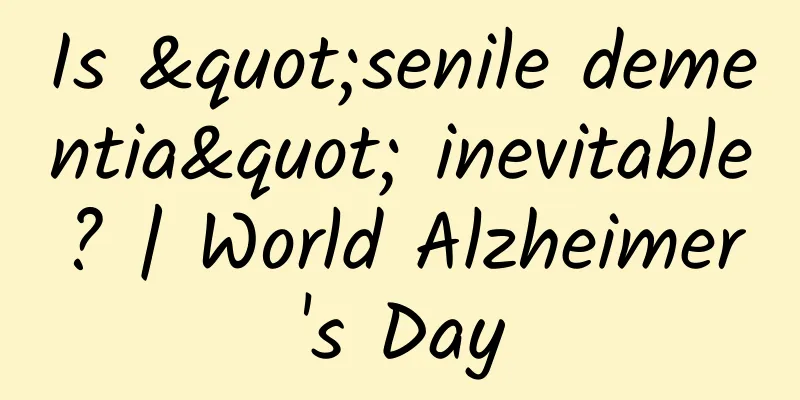Is "senile dementia" inevitable? | World Alzheimer's Day

|
As we age, we may experience forgetfulness and decreased thinking ability. Are we "getting old and confused"? This may be a natural thought, but it may also be a symptom of dementia. There are many different types and causes of dementia, and Alzheimer's disease, which is often mentioned, is just one of them. Humans are slow to understand dementia. Today, hundreds of new drug trials for Alzheimer's disease have not made any breakthrough progress, and there is still no specific drug, and we are entering an aging society. In her book "Silver Hair Generation: Redefining Old Age, Rethinking the Medical System, and Reconstructing Older Life", Lousie Aronson, a professor of geriatrics in the United States, discussed in detail the problems faced by elderly patients in modern medicine based on her own learning and professional experience. In terms of dementia and Alzheimer's disease, we found that the actual number of patients is not as high as expected, and the reason is the lack of diagnostic methods and insufficient doctor skills. How should we face such problems? In addition to continuing scientific exploration, we should pay more attention to the humanistic care aspect. As the theme of this year's World Alzheimer's Day is "Understanding Dementia, Understanding Alzheimer's Disease", special attention should be paid to support after diagnosis. By Lousie Aronson Translations | Jiang Yiqi, Zhang Guanglei, Zhou Zhe Before I became a doctor, I thought senility was a normal part of aging. I thought if you lived long enough, your memory would fade. I also didn’t realize that senility was a common name for dementia, and that one condition, Alzheimer’s disease, has more than 70 medical causes. I also didn’t know that you could live into your 80s, 90s, or 100s without developing dementia without suffering from one of these conditions. These days, we hear a lot about dementia and its common types. Twenty years ago, Alzheimer’s disease wasn’t included in that category. But I should have been more familiar with dementia based on my observations of the elderly in my family. My grandmother and great-grandmother both lived to be 90 and never had any brain problems; my grandfather did the same, dying at 86; and my grandmother and her sisters all died in their 70s. Incredibly, despite my own experience to the contrary, I thought dementia and aging were the same thing. I'm not the only one who has this misconception. Dementia never appeared on the Centers for Disease Control and Prevention's (CDC) list of the top 10 causes of death in the United States for all ages from 1933 to 1998. Alzheimer's disease first appeared on the list in 1994, as the eighth leading cause of death for women, and did not appear on the list of causes of death for men or on the list of causes of death combined until 1999. Why did Alzheimer's disease enter the public consciousness only later in the 20th century? The explanations are different from those for HIV or Zika, which were either newly discovered pathogens or had a short history of infecting people. Alzheimer's disease has also gained public attention not just because people are living longer, although this has affected the incidence of the condition. At the same time, public and medical awareness of the disease has also improved. Part of the change is that doctors filling out death certificates are simply the product of their environment and daily medical training. In daily life, if doctors hear about it, they are hearing about senility, not dementia. Dementia is not as prominent in textbooks as common, life-threatening diseases. It may make sense to regard the disease as a normal part of aging, but some people would say that any problem that affects a person's body, organ function and health should be considered a health problem. If doctors weren’t trained to assess or treat these conditions, they wouldn’t appear on death certificates. Licensed clinicians or CDC scientists might have thought that dementia and senility went hand in hand and were less important than heart disease and cancer. As of 2007, Alzheimer's has become the sixth leading cause of death in the United States for people over 80. On its own, it ranks fifth among men and third among women, but that's not entirely true. In many ways, in the 20th century, the CDC's list of causes of death was presented as broad categories of disease, such as heart disease, cancer, and accidents (unintentional injuries). As a result, many diseases were included in these broad categories, so the number of deaths in each category was high. If we count heart attacks, heart failure, irregular heartbeats, and other heart diseases separately and count cancer as a single disease, heart disease would not be at the top of the list, but cancer would be; if we break down cancer into categories and list breast, lung, skin, prostate, colorectal, blood, and other cancers separately, cancer would drop slightly. But the CDC lists Alzheimer's as a single disease, not lumped in with the many other dementias. A more rational taxonomic approach would be to consider dementia as a separate category that includes vascular dementia, Lewy body dementia, frontotemporal dementia, and other types of dementia. This classification is important because where the disease appears on the CDC list and other lists affects all aspects of the health care system—from physician training to research and funding for specific parts of the health care system, as well as changing public perceptions and our political and social priorities. A mysterious fog Serious illness always changes a lot. My father was still the same father in my eyes until he died at the age of 84, but in the last few years of his life, he looked less and less like the father I had known for 48 years. The changes brought by dementia to patients are a double loss to the patients' families. First, the familiar face and body seem to be filled with a stranger. Second, many years later, the patient dies and everything turns to ashes. In "Elegy for Iris", the author John Bailey has been caring for his lover, the writer Iris Murdoch. When Iris entered the late stage of dementia, John Bailey described her physical condition like this: "Alzheimer's disease is actually like a hidden fog, which is difficult to detect until everything around you disappears. After that, it is difficult to believe that there is a world outside the fog." I don't know whether Bailey deliberately made an ambiguous description to his wife, to himself who was caring for his wife, or to both of them. My father, who did not live to see the end of dementia, was able to hide his condition from those around him who did not know him until the last year or two of his life. Once, my father and I were with my mother in an emergency room cubicle after she fell and hit her head due to a stomach upset. The nurse asked my father to sign a document that he could not fully understand. Later that day, the hospital diagnosed that the trauma to my mother's head was the most serious part of the injury. An emergency room doctor came to see her—a man who had won many awards for his meticulous thinking and knowledgeable approach. He said that the documents would take time to prepare and I could go back to work. Apparently, he did not notice my father's fuzzy thinking, his sometimes incoherent speech, and his slovenly appearance—because my mother was not there to supervise him that morning. In other words, the doctor failed to combine these manifestations into a reasonable judgment. I told the doctor that I had to stay with my father and that without my help, my father would not be able to find the bathroom, the coffee shop upstairs, or my mother's cubicle. The early stages of dementia are subtle and difficult to detect, and only those who are professional or observant can see them. French writer Anne Ernault described her mother in the months before she was diagnosed with Alzheimer's disease: She changed. She started laying the table early... She became short-tempered... She panicked when she received a notice from the pension fund... Then things started happening. She waited on the platform for a train that had already passed. When she was ready to go out to buy something, she found that all the shops were closed. She kept losing her keys and she seemed to be on guard against some invisible threat. Alzheimer's disease is the most common form of dementia, and by standard definitions, it develops gradually. Symptoms begin years before diagnosis, and are subtle at first and often attributed to age or carelessness. People say their brains are "old," laughing but frightened at the same time. After cancer, the disease Americans fear most is dementia. Age changes the brain, and changes lead to dementia. Things that were once easy become challenges for people with dementia, such as managing money, taking medications, shopping, cooking, and driving. Slowed reaction times, memory loss, and easy distraction are inconvenient, but not disastrous. They are fundamentally different from being unable to roughly imitate a simple painting or naming only a few animals within a given minute. People with healthy brains who are old do things more slowly or differently because they have to work harder to control their hands, eyes, and brain, but they get the job done anyway. Many Americans have dementia: 5.3 million people had it in 2015, 4.5 times more than the number of people with AIDS. One analysis shows that only 50% of people with dementia are diagnosed. Although most older people do not have dementia, age is a significant risk factor. 80% of people with dementia are over 75 years old. On average, 14% of people over 70 have dementia. Black Americans are more likely to develop dementia than white Americans, with Latinos in the middle and Asians having the lowest rates; there are also significant differences among ethnic subgroups. After being diagnosed with Alzheimer's disease, people live an average of 8 to 12 years, usually dying from heart disease or cancer, which is consistent with the situation of older people of the same age. Dementia usually develops gradually, but it can also worsen suddenly due to medication, infection or stroke, with a significant decline in brain function, but it is usually treatable. There is no standard definition of dementia, and the reality faced by everyone affected by it is complex, worrying, interesting, frustrating, grateful, tragic and profound. Difficult to diagnose As medicine has developed to date, although patients with dementia require the expertise of doctors from different fields, only students in neurology, psychiatry, and geriatrics have sufficient knowledge of this disease during their medical studies, and each branch has a different focus. Neurology students prefer to make diagnoses through brain pathology and treat with drugs; psychiatry students focus on anxiety, depression, and psychotic symptoms in patients with dementia; geriatrics is a new discipline in the medical system with a relatively small number of students. They focus on the management of patients' health, the social environment, and the physical environment in which they live, in order to maximize the physical and mental health of patients and caregivers. Today, most doctors have some understanding of dementia, but compared with their understanding of other common and fatal diseases, it is still far from up to standard. Since the 1980s, studies have been published regularly finding that doctors often miss diagnosing dementia until at least the middle stages of the disease. At the University of California, San Francisco, where I work for much of my career, only 3% of patients over 65 were documented to have some kind of cognitive impairment in 2018—far fewer than we would have expected. Recent studies are exploring why this is the case. Some clinicians don’t have the expertise; some report that they suspect their patients have the condition but don’t feel the need to make the diagnosis because they can’t prescribe treatment; and others admit that they lack the time or the tools to diagnose this elusive disease. Dementia also forces us to rethink what it means to be human. If an accurate definition of who has dementia included the people around them, we might find it easier to deal with a disease that strips many of its sufferers of their basic humanity. We might have a broader conception of what constitutes “medical” treatment, more doctors with the necessary caregiving skills, and a health-care system more flexible to respond to the highly differentiated needs of patients. Scientific exploration and medical practice go hand in hand In 2010, I was invited to give a lecture on “Rethinking Geriatrics” for a continuing education course. Each speaker was asked to select and translate the most influential research in his or her field over the past 12 months. One day after I submitted my talk, the course director responded: “You can’t talk about dementia because someone else is already going to talk about it.” Under the leadership of this man, a renowned researcher in the field of dementia and the head of a large memory research center, this small project has become an active center for research, teaching, and clinical treatment. “I’m sure we talk about different things,” I responded, explaining that neuroscientists focus on the scientific side of things, while I discuss clinical treatments. The course director was unimpressed: “We need to make sure the same material doesn’t appear twice.” Given our different focus and the fact that the dementia field has published over 1700 articles in the past year, I felt we could avoid duplication. “Here’s what I’m going to do,” I suggested. “I’ll take his lecture outline or his slides, and if there’s any duplication, I’ll take out the dementia stuff. But if we’re talking about different research, then I’ll keep it.” The course director agreed, and I sent an email to the researcher. A few weeks later, I received a friendly email reply with his slides. The slides focused on the molecular changes and where drugs work in different cases of dementia, especially in rare cases. The slides included electron microscope images and positron emission tomography scans of diseased brains from Nature and other journals. His lectures looked great, showing the audience the latest information on the current biology of aging. For the dementia part of my lecture, I selected three studies from top clinical journals. The first study established the precursor symptom criteria for the diagnosis of dementia, namely mild cognitive impairment, the second was a guideline for the assessment and management of driving risk in patients with dementia, and the third was a large study on the quality of life and hospitalization of patients in the late stage. I emailed the Director of Continuing Education to assure him that there was no overlap between my lectures and the researcher’s. Science is essential to understanding and advancing medicine, but it does not always have direct implications for patient care. Viewing the helical filaments in the brains of people who have died of frontotemporal dementia through an electron microscope can help doctors understand how and why the disease is different from other dementias, but it will neither tell doctors how to diagnose or treat people with the condition nor help caregivers manage these patients to avoid the often unacceptable behaviors they engage in. In contrast, recognizing that survival rates for advanced dementia are similar to those for metastatic cancer or advanced heart failure can provide doctors with crucial information about how to help patients and families make end-of-life arrangements and reduce stress and physical suffering before death comes. The researcher’s talk reflects not only his own focus but that of the medical community as a whole. While the 20th century saw advances in laboratory tests, radiological research, medical treatments, and drugs, these factors were viewed as the main and only components of care. This view is particularly problematic when it comes to dealing with dementia. Despite advances in diagnosis and the availability of some mildly effective drugs, the knowledge and skills required to care for patients come from a toolbox that extends beyond these categories. This expertise includes helping patients manage the daily challenges and practical stress of a dementia diagnosis, communication skills with people with different types and degrees of cognitive impairment, and the ability to recognize and manage caregiver stress. This requires researchers to have knowledge not only of the drugs involved, but also of social, behavioral, and environmental approaches that are less side-effective and more effective in addressing the symptoms of the disease, as well as advanced skills in life planning, family comfort, conflict management, and critical decision-making in complex situations as the disease progresses. Years later, I learned that I had underestimated this researcher, whose research center was conducting geriatric-based research and teaching on dementia treatments while still focusing on cutting-edge science and neurological assessments. He is the future "us" There is no way to prevent or treat dementia, but some common forms can be slowed by reducing the same risk factors as heart disease, stroke and some cancers, including regular exercise, a healthy diet and avoiding obesity and tobacco. But doing so is hard if you don’t have money, access, education, resources or confidence to adopt a healthy lifestyle. This is partly why rates vary across ethnic groups. It’s even harder if your community has long been poor and has traditions, including favorite foods and family activities that are meaningful to residents but not good for health. Some health risks can be attributed to personal choices and behaviors, and the way we were raised makes it easier for some of us to succeed than others. Dementia, like other diseases, is about social inequities that lead to poor health and unnecessary medical expenses. In many ways, dementia is a reflection of how America is dealing with its aging population. How and when we discuss it, whether we understand its impact on our lives, and whether we have adopted social and medical approaches in recent decades are a perfect reflection of our attitudes and approaches to the aging reality. The questions we ask about dementia can be applied to the issue of old age: Who is this altered self? Where do we fit in, and how do we connect to society and to others? There is a huge difference between an elderly person who can’t run 10 kilometers but works as a cashier, appears before the Supreme Court, provides after-school care for grandchildren, drives for an online ride-hailing company, works as a museum docent, or runs a medical center, and an elderly person who can’t find his own home or remember the names of his children. But the similarities are that they are both human beings who need attention and care. The former may become the latter, and the latter was once the former. They are the future “us” and we are the past “them”. About the Author Lousie Aronson is a professor of geriatrics at the University of California, San Francisco (UCSF) School of Medicine, an integrative geriatrician at the UCSF Osher Center, and director of the Health Humanities and Social Advocacy Program. She graduated from Harvard Medical School with a Doctor of Medicine degree and completed the Warren Wilson School Writers MFA Program, where she received a Master of Arts degree. She has won the Humanism Gold Award, the California Family Care Physician of the Year Award, and the American Geriatrics Society's Outstanding Mid-Level Clinical Teacher of the Year Award. Her work has been widely published in newspapers and magazines, and her book Elderhood: Redefining Aging, Transforming Medicine, Reimagining Life was shortlisted for the Pulitzer Prize for Nonfiction. This article is authorized to be excerpted from the section "Is 'old age confusion' inevitable?" in Chapter 4 of "The Silver Generation: Redefining Old Age, Rethinking the Medical System, and Reconstructing Older Life" (CITIC Publishing Group, 2022.7), with slight modifications and the subheadings added by the editor. Special Tips 1. Go to the "Featured Column" at the bottom of the menu of the "Fanpu" WeChat public account to read a series of popular science articles on different topics. 2. Fanpu provides a function to search articles by month. Follow the official account and reply with the four-digit year + month, such as "1903", to get the article index for March 2019, and so on. Copyright statement: Personal forwarding is welcome. Any form of media or organization is not allowed to reprint or excerpt without authorization. For reprint authorization, please contact the backstage of the "Fanpu" WeChat public account. |
<<: Sharing washing machines and toilets can actually lead to HPV infection?
Recommend
How to use AED and seize the golden 4 minutes of "sudden death rescue"?
On the evening of June 30, a young athlete from t...
Can a unicornuate uterus conceive naturally?
A unicornuate uterus is a type of uterine malform...
Can a 17-year-old girl with gynecological inflammation be cured?
A 17-year-old girl with gynecological diseases ca...
How to treat yellow leucorrhea and lower abdominal pain
Generally, middle-aged women will suffer from gyn...
Six people were infected in one meal! Can boiling the dishes and chopsticks before eating really disinfect them?
Confirmed cases in Shanghai involved 4 restaurant...
What are the signs of ovulation?
Women have menstruation and ovulation every month...
What is Down syndrome in pregnant women?
For women, getting married and having children ar...
Uterine pressure 100
Childbirth is a very difficult process for women....
How to curl lower eyelashes
Eyelashes are divided into upper eyelashes and lo...
It is the best health food in summer! It is not watermelon or grapes, and eating more can prevent cancer!
Author: Fluent Although today's showers have ...
Seven months pregnant, the stomach is tight and hard
I believe that many people who have experienced t...
What is the cause of the pimples on the inside of the vulva?
Doctor's reminder: Generally speaking, small ...
My myopia is only 300 degrees, why does the doctor recommend ICL?
Decided to have myopia surgery Laser or lens impl...
What foods can help women delay aging?
Women will be very disappointed when talking abou...
Seven months of fetal movement frequency and precautions
We all know that each of us comes into this world...









